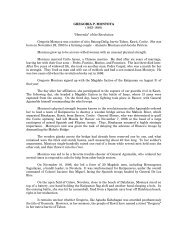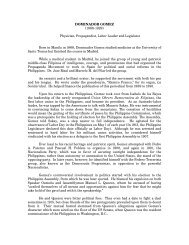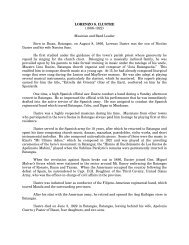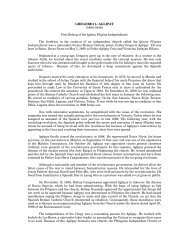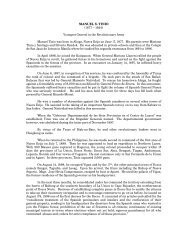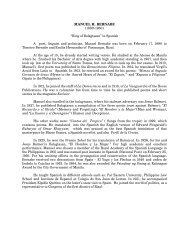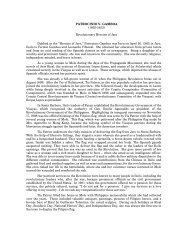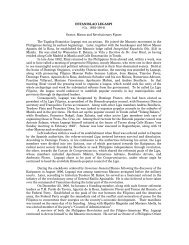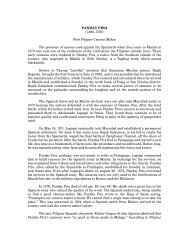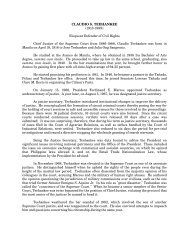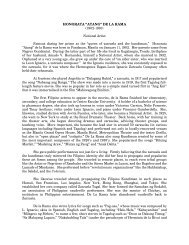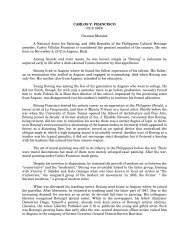JOAQUIN G. PARDO DE TAVERA (1829-1884) Reformist Born on ...
JOAQUIN G. PARDO DE TAVERA (1829-1884) Reformist Born on ...
JOAQUIN G. PARDO DE TAVERA (1829-1884) Reformist Born on ...
You also want an ePaper? Increase the reach of your titles
YUMPU automatically turns print PDFs into web optimized ePapers that Google loves.
<str<strong>on</strong>g>JOAQUIN</str<strong>on</strong>g> G. <str<strong>on</strong>g>PARDO</str<strong>on</strong>g> <str<strong>on</strong>g>DE</str<strong>on</strong>g> <str<strong>on</strong>g>TAVERA</str<strong>on</strong>g><br />
(<str<strong>on</strong>g>1829</str<strong>on</strong>g>-<str<strong>on</strong>g>1884</str<strong>on</strong>g>)<br />
<str<strong>on</strong>g>Reformist</str<strong>on</strong>g><br />
<str<strong>on</strong>g>Born</str<strong>on</strong>g> <strong>on</strong> September 19, <str<strong>on</strong>g>1829</str<strong>on</strong>g> in San Roque, Cavite, Joaquin Pardo de Tavera was the s<strong>on</strong> of<br />
Julian Pardo de Tavera, a lieutenant in the army, and Juana Maria Gomez, both Spaniards<br />
according to Manuel Artigas. He was <strong>on</strong>e of the couple’s two children who grew up to maturity.<br />
His <strong>on</strong>ly other sibling was Felix, who became the father of Trinidad Hermenegildo Pardo de<br />
Tavera.<br />
In 1849, after his preparatory educati<strong>on</strong> at the Colegio de San Juan de Letran, Pardo de<br />
Tavera entered the University of Santo Tomas for a course in can<strong>on</strong> law, which he finished in 1852.<br />
He took up derecho patrio completing it not l<strong>on</strong>g after, and obtaining a lawyer’s license in 1857.<br />
Shortly thereafter, he received his appointment as relator of the Real Audiencia, which he<br />
turned down, however, because he was sickly. Later, he was appointed lieutenant governor of the<br />
Batanes Islands, a positi<strong>on</strong> he did not hold for l<strong>on</strong>g.<br />
Pardo de Tavera began practicing his professi<strong>on</strong> when he joined the law firm of his old<br />
mentor, Dr. J.M. Jugo, and, afterwards, that of Francisco Licaros, another reputable lawyer like<br />
Jugo, carving his own niche with his set of clients by the time he established a law office of his own.<br />
In 1861, he was appointed promotor fiscal of Manila, and was reappointed the following<br />
year for another term. Thereafter, he served c<strong>on</strong>secutively as teniente fiscal at the Real Audiencia,<br />
and as C<strong>on</strong>sejo de administración, in the latter succeeding his own brother Felix when he died.<br />
When his former teacher Francisco de Mercaida resigned as professor in derecho patrio at<br />
UST in 1866, Pardo de Tavera took over the positi<strong>on</strong>, but <strong>on</strong>ly after hurdling a battery of tests. In<br />
1865, shortly after he received his doctor en jurisprudencia degree, he was promoted to the post of<br />
catedrático de derecho patrio. It must be noted that during his studies for a doctorate, Fr. Jose<br />
Burgos was also taking his doctorate in can<strong>on</strong> law. Thus, it is very likely that he and Burgos and<br />
other campus figures with a similarly progressive bent, associated and engaged in discussi<strong>on</strong>s, thus<br />
c<strong>on</strong>tributing to the rise of liberal thinking.<br />
Outside his teaching job at UST, he served as board member of such instituti<strong>on</strong>s as Obras<br />
Pías, Colegio de Santa Isabel, Real Hospicio de San José, and Sociedad Ec<strong>on</strong>ómica de Amigos del<br />
País.<br />
Pardo de Tavera’s liberalism and brilliance were admired by his students with whom he<br />
established rapport by mingling and chatting with them after class. A number of them, like<br />
Florentino Torres, Ant<strong>on</strong>io Ma. Regidor, Mamerto Natividad, Felipe Buencamino, Sr., and Hugo<br />
Ilagan, eventually became leaders in the reformist movement.<br />
Pardo de Tavera led the laymen’s branch, composed of lawyers and businessmen, of the<br />
progressive Comité de Reformadores, which gained the support of Carlos de la Torre, the liberal<br />
Spanish governor-general. Availing of the atmosphere of tolerance, the Filipino reformists began a<br />
vigorous propaganda campaign aimed at gaining the same freedoms that Spaniards enjoyed since<br />
their own Revoluti<strong>on</strong> in 1868.<br />
The reformists suffered a setback when Rafael Izquierdo, a reacti<strong>on</strong>ary, succeeded De la<br />
Torre. The situati<strong>on</strong> became tense as c<strong>on</strong>servative elements, who had been biding their time,<br />
regained their dominance in Philippine society. It was rather volatile in the ecclesiastical circle,<br />
owing to the growing movement for the secularizati<strong>on</strong> of parishes. Thus, when soldiers and<br />
workers at the Cavite Arsenal raised the flag of rebelli<strong>on</strong> in February 1872, church authorities used
the incident to get rid of all reform-minded Filipinos, particularly the secularists, who were<br />
implicated, or simply suspected of involvement, in the revolt.<br />
Pardo de Tavera and his associates in the Comité de Reformadores were am<strong>on</strong>g those<br />
accused and arrested <strong>on</strong> January 21, 1872. He was ordered banished to the Marianas for six years.<br />
Having joined him there, his wife Gertrudes Garricho provided him comfort and c<strong>on</strong>solati<strong>on</strong>. An<br />
unexpected turn of events, nevertheless, by way of a royal pard<strong>on</strong> issued <strong>on</strong> November 23, 1874,<br />
cut short his exile. He chose, however, not to return to the land of his birth, but to live the<br />
expatriate’s life. That same year, he and his wife left for Paris, where he died <strong>on</strong> March 19, <str<strong>on</strong>g>1884</str<strong>on</strong>g>.<br />
He was buried in the Cementerio del Padre Lachaisse.<br />
Pardo de Tavera had three children: Eloisa, married to Daniel Earnshaw; Beatrice, married<br />
to Manuel de Yriarte; and Joaquin, who <strong>on</strong>ce served as director of the Nati<strong>on</strong>al Bureau of<br />
Investigati<strong>on</strong>.<br />
References:<br />
Artigas y Cuerva, Manuel. Nati<strong>on</strong>al Glories: The Events of 1872, A Historico-Bio-<br />
Bibliographical Account. Translati<strong>on</strong> and Notes by O.D.Corpuz. Quez<strong>on</strong> City:<br />
University of the Philippines Press, 1996.<br />
Manuel, E. Arsenio. Dicti<strong>on</strong>ary of Philippine Biography. Volume I. Quez<strong>on</strong> City:<br />
Filipiniana Publicati<strong>on</strong>s, 1955.<br />
Schumacher, John N. Revoluti<strong>on</strong>ary Clergy, The Filipino Clergy and the Nati<strong>on</strong>alist<br />
Movement, 1850-1903. Quez<strong>on</strong> City: Ateneo de Manila University Press, 1981.



